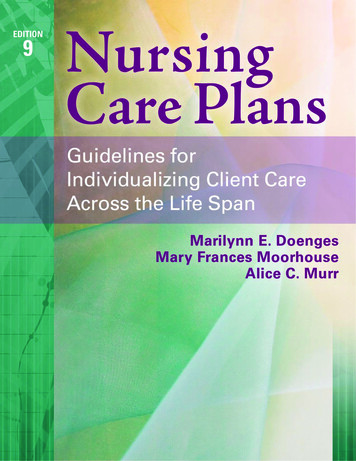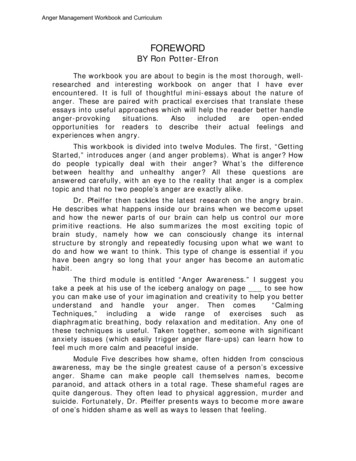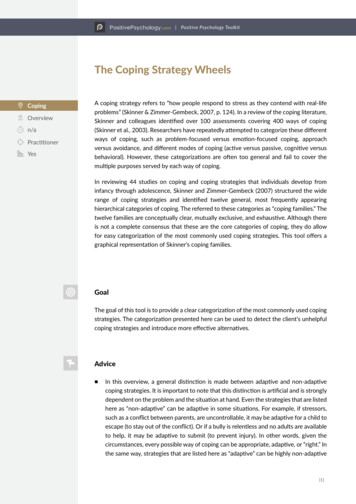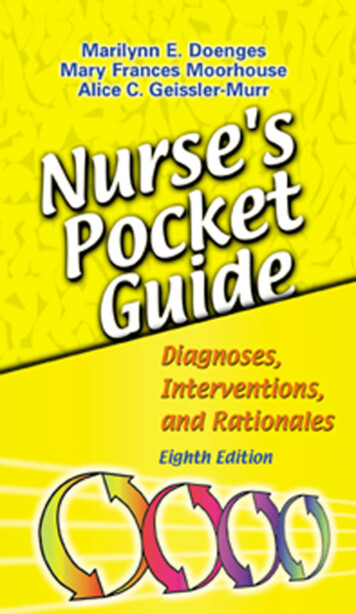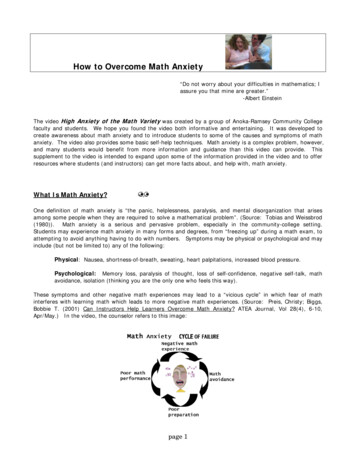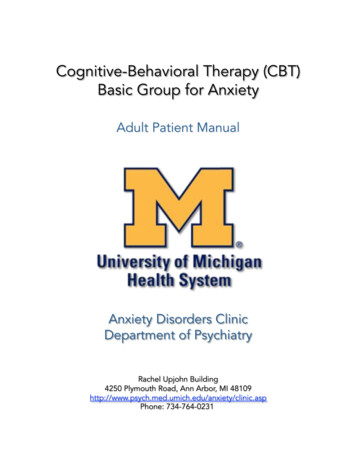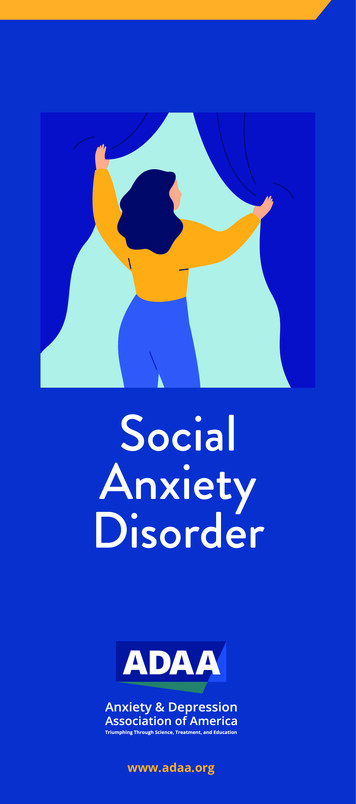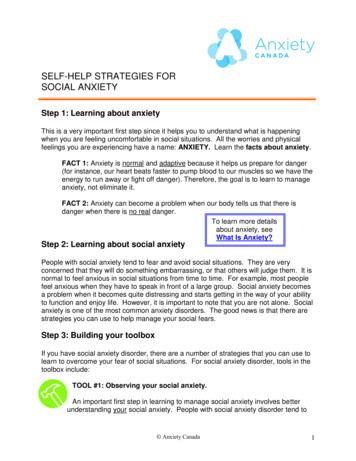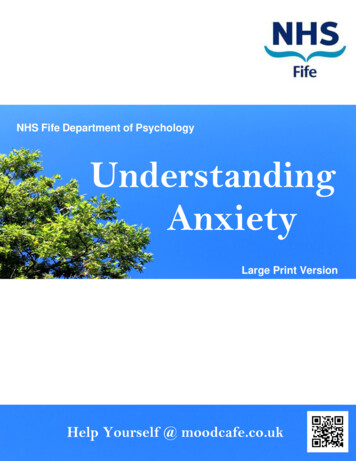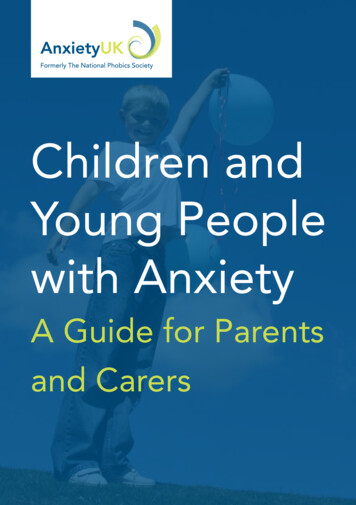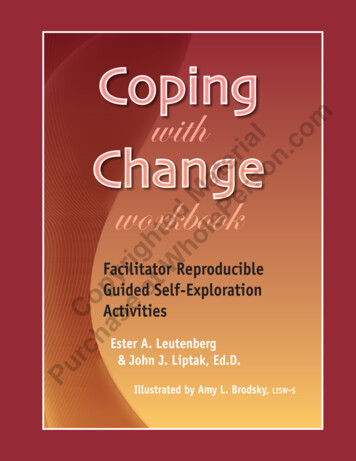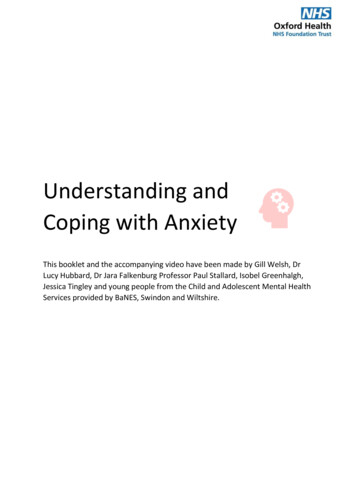
Transcription
Understanding andCoping with AnxietyThis booklet and the accompanying video have been made by Gill Welsh, DrLucy Hubbard, Dr Jara Falkenburg Professor Paul Stallard, Isobel Greenhalgh,Jessica Tingley and young people from the Child and Adolescent Mental HealthServices provided by BaNES, Swindon and Wiltshire.
Part 1. Understanding AnxietyAnxiety is a normal reaction. Everyone will feel anxious at some stage. Anxiety is designed to keepus safe by preparing us to deal with challenges or situations that are dangerous or threatening. Itdoes this by: Keeping us alert so that we are able to spot and avoid danger Preparing our bodies so that we can quickly take some action to keep safe Helping us learn how we can keep out of future danger and stay safeWhen we perceive a threat our body prepares us to deal with it. This is often called the fight or flightresponse. This prepares us to avoid or run away (flight) or to confront and face the threat (fight).For example: You will need to jump out of the way of the car to avoid being hit (flight) You will need to quickly leave the building when the fire alarm sounds (flight) You may need to fight off an attacker (fight)Fortunately, for most of us, there are relatively few real threats to our physical safety. We don’thave to avoid runaway cars or fight off attackers every day. However, many of us feel anxiousbecause we imagine threat. We worry about what might happen and imagine that: Things will go wrong – e.g. we will get lost if we go somewhere new We will be unable to cope – e.g. we won’t know what to say to someone or theywill laugh at us We will be unsuccessful – e.g. we will get our work wrong or fail our examsBecause we are always imagining threat we may live in a constant state of anxiety.Fight or FlightThere are 3 core parts of the flight or fight anxiety response:1. How we think. This helps us to identify situations or events where there might be possible threator danger. Often this is what we think will happen and how we will be unsuccessful or things will gowrong.2. How we feel. This is the response that prepares our bodies to take some action to deal with thethreat. We may notice our heart racing, that we feel hot, short of breath or go red. We may feeltense or on edge.3. What we do: We learn how to keep ourselves safe and out of future danger. Often this involvesavoiding the situations or things that we worry about and which make us anxious.
1. How We ThinkWhen we feel anxious we are more likely to expect the worst. We are more likely to think that: We will be unable to cope We will get things wrong That bad things will happen That people will laugh at us or be unkind We are more likely to look for signs of dangerThese ways of thinking can make us believe we are living in a dangerous world which we are unableto cope with.2. How we feelThere are many possible symptoms of anxiety, including:Feeling tenseFast breathingHeadachesFeeling dizzyGoing red / blushingAlertShakingFeeling hotButterfliesRacing heartDry mouthSweatingWanting to go to the toiletOther possible symptoms of anxiety include: Difficulty concentrating Not wanting to go out Problems sleeping Not eating Feeling unwell and sick Being irritable Temper outbursts Thinking about your fears all the time
3. What We DoWe learn from what has happened and use this information to deal with future or similar events. Forexample, If you were laughed at in class for wrongly answering a question you might not answerfuture questions as you may think that you will get it wrong. Or, If you had a panic attack when you were shopping, you might stop going to the shops. Youmay think that you won’t be able to cope and so decide to stay at home. Or, If you were meeting someone you care about and they were very late, you might think thatthey have had an accident. You may want to be constantly in touch with them and neverleave them so that you make sure they ok.We learn to avoid or stop doing things that make us anxious.The Anxiety TrapWorrying thoughtsThink that we will beunsuccessful, can’tcope, things will gowrongAvoidanceAnxious feelingsAvoid the things thatmake us anxiousBody changes, racingheart, feel hot,butterfliesAnxiety not only feels uncomfortable but it can have a significant effect on your everyday life. It can: Limit what you do and where you go. You may not want to leave the house or meet upwith friends. You may not want to go to school and this will have an impact on youracademic performance. Put a strain on your relationships. You may find you argue more with friends and family,they may try and make you do things you don’t want to do and get cross with you if youdon’t. Friends may stop asking you to join them. Limit your social and relaxation time. You may not feel able to go to the cinema, out for ameal or go on holiday, you may not be able to take part in clubs that you used to enjoy
Types of anxietyThere are several different types of anxiety but all are likely to make you think that there will be abad outcome. You may worry about anything and everything and expect that everything will go wrong.You may worry all the time. This is called generalised anxiety. You may worry about what other people think about you, and you may think they will findyou boring or that you have nothing to say. This is called social anxiety. You may experience intense episodes of fear that seem to come out of the blue, and makeyou feel out of control. You may worry you are having a heart attack or even dying. Theseare called panic attacks. You may have specific fears of things like animals (dogs or spiders). These are calledphobias.Causes of anxietyThere is no single reason why people become anxious. Often it is a combination of factors including: Genetics – Research has shown that we may inherit a predisposition or tendency to beanxious. Life events – Anxiety can be triggered by stressful events. These could be anything such asfriendship and bullying issues, physical injury or illness, bereavement, moving house orschool, family problems. Global issues, such as climate change are also a source of anxietyfor many. Family factors – Anxious children and young people are more likely to have anxiousparents/carers and, therefore, they may learn unhelpful ways of coping with stress/anxietyfrom their parents/carers. Character – You may just be the kind of person who struggles more with shyness andworries about new and unfamiliar situations.
Part 2. Learning to Beat Your AnxietyOne of the recommended treatments for anxiety is Cognitive Behaviour Therapy (CBT). CBT targetsthe three key parts of the anxiety response. How we think. It helps us to question the way we think about events and situations andhow we see threat and danger. How we feel. It helps us to understand, manage and tolerate our anxiety symptoms What we do. It helps us to change what we do by confronting and facing our fearsIt helps to break out of the anxiety trap, to deal with worries in a more balanced and helpful way.The aim is to move from the anxiety trap:To more balanced thinking:Helpful thoughtsMore balanced,recognise strengths,positives and copingCopingFace and cope withchallengesPleasant feelingsLess anxious andmore positiveemotions
For example, CBT can help you move from:To more balanced thinking:The goalThe goal is to learn to cope with anxiety not to get rid of it, no one is anxiety free. This is normal,and as we have already seen, anxiety can be helpful. You will continue to feel some anxiety, but youwill be able to cope and manage it, and it won’t stop you from living your life and doing what youwant to.It can be helpful to set yourself a goal, this will remind you of the bigger picture when youare feeling anxious about trying new things. There is a Goal Setting worksheet that will helpyou identify your goal.
The WorksheetsAlongside this booklet are some worksheets that can help you learn to manage and beat youranxiety. These will take you through the following 5 steps to coping with anxiety:1. Understanding anxiety2. Learning to stay calm3. Identifying and challenging anxious thoughts4. Facing your fears5. Learn to solve problemsSupportYou can do this on your own but sometimes it can be really helpful to have someone to talk thisthrough with. For example – you may feel you can talk to a parent/carer or trusted adult and theycan help you without interfering. Or you may have a partner or close friend who understands howhard you are finding things and would be willing to listenTheir job is to listen and help you think, NOT to solve it for you.Step 1. Understanding Your AnxietyThe first step is to help you understand more about your anxiety. You have to know your enemy! Wedo this by asking the following questions How often do you feel anxious?Where and when do you feel anxious?What makes you feel anxious?What thoughts race through your mind when you feel anxious?What do you do when you are anxious?A helpful way of doing this is to keep a diary. A diary is included in the accompanying resources.Monday7 30Getting ready for schoolI’m sure I’ve forgottensomethingHot, racing heart,sweating
After completing the diary for a week or two, make some quiet time to review it. You could do thiswith your support person. You are looking for any patterns that will help you manage your anxiety. Are their particular days or times when you feel anxious? Are there common situations which make you anxious? Are there any common thoughts when you become anxious? What are your strongest and most common anxiety body signals?The second thing we need to do is to help you identify your anxiety signals. Remember all thesebodily sensations are normal, it is your body responding to what it thinks is danger. It is not a signsomething is physically wrong with youIf you are able to spot when you are becoming anxious, by noticing your body signals, you can dosomething to help yourself feel better before it becomes overwhelmingHave a look at the worksheet, My Body Cues and see if you can identify which signals youexperienceStep 2. Learning to Stay CalmOnce you understand your anxiety and can spot when you are feeling anxious, the second step is todo something about it.There are many ways we can help ourselves to feel better and to relax. There is no one way that willalways work. You may already know things that you can do to feel calm, and it is worth trying lots ofthings and building up a toolbox of different ways to stay calm. That way, if something doesn’t workon one day, you can try another.With relaxation we know that practice makes perfect, try and build it into your routine to make sureyou keep practicing, for example do it just before you go to bed.You could also ask your support person what makes them relax and feel calm, and see if it works foryou.The Control your Anxiety handout provides a number of different ideas. Find out which workfor you.Step 3. Identifying and challenging anxious thoughtsThe third step is to help you find out more about the way you think and your worries. We all havenegative, critical and worrying thoughts at times. This is normal. The difference when you areexperiencing anxiety you think like this all the time. It becomes hard to recognize your successes orwhen you do cope.You become trapped in these negative and unhelpful ways of thinking. When you are anxious, youare more likely to think that:
You will be unsuccessful – “there’s no point trying I know I can’t do that” You will be unable to cope - “I won’t know what to say if my teacher asks me a question, Iwill go bright red” That bad things will happen – “what if I get lost” or “everyone will laugh at me” You will get things wrong - “I never get this work right” Other people are negatively judging you – “people think I look stupid”Thoughts like these are unhelpful: They make you feel unpleasant and increase their anxiety They are demotivating and don’t encourage you to give things a try They stop you from living your lifeTo help you get out of this negative trap you need to develop more balanced ways of thinking. Youmay have noticed that your thoughts tumble around in your head like they are in a washingmachine. You can lose hours listening to them and end up feeling very anxious. This is calledruminating. When you are ruminating you look for and listen to all the evidence that you areunsuccessful and can’t cope.What you need to do is actively search for those times you have been successful and coped.Instead of simply listening to the unhelpful thoughts that tumble around your head you need tocheck them out and see if you are seeing the whole picture.A positivity journalTo counter your tendency to focus on the unhelpful thoughts (not coping or being unsuccessful) youcan keep a log of all the positive and good things you have done or been part of. Each day, identifytwo or three positives things that have happened. These could be examples of Coping with a difficult situation or task Facing a situation that made you feel anxious Having a go at something new Being successful (this does not have to be something major, but can be something along thelines of ‘helped someone who was lost by giving them directions’)Because you are so used to looking for evidence of being unsuccessful, it may be really difficult atfirst. This is where you could call on your support person. They can help you think about your wholeday and notice when things have gone well. You can ask more than one person too!As your positive log grows it will help you realise that although things can be hard, you can besuccessful, you can cope and you can face your fears.A Positivity Log is included in the accompanying resources.
Check out the way you thinkBecause we hear our negative and unhelpful thoughts so often we simply believe them and don’tstop to check them out. We need to train ourselves to check out what we are thinking and todiscover whether there may be a more balanced and helpful way of thinking.This can be done by using the Catch it, Check it, Challenge it, Change it technique. There is aworksheet in the accompanying resources to help.1. The first step is to Catch the unhelpful thought that is making you feel anxious.2. The next step is to Check it. Are your fears justified or are you exaggerating things? Are youblowing things up to be more than they really are? What evidence is there that your thoughtis right?3. The third step is to Challenge it and to look for any evidence that supports and challengesthis way of thinking. Is there something positive and helpful that you might haveoverlooked?4. The final step is to Change it. On the basis of the evidence, is there a more balanced andhelpful way of thinking about this?So how does this work?Do you remember the thinking trap from earlier? These were the worrying thoughts Alex washaving:Worrying thoughtsI can’t do it,everything will gowrong, people willlaugh at meLet’s Catch, Check, Challenge, and Change Alex’s unhelpful thoughts:
By doing this you can learn to accept that you will feel anxious but it helps to put things inperspective. Things didn’t go to plan for Alex but it only happened once. Someone else was to blame but Alex thought of a solution, the friends worked together Alex does have useful ideas and friends value them, even if some laugh to begin with This way of thinking is more balanced and helpful and reduces Alex’s anxiety.What would my best friend or support person say?Another way we can check our thinking is to ask ourselves what someone we respect or value wouldsay if they heard our negative thoughts. Many of our thoughts stay in our heads and we don’t saythem out aloud or question them.Use the What would my Best Friend/support person Say worksheet in the resource pack.Write down the anxious thoughts. Now ask yourself to imagine what your best friend or supportperson would say if they heard you thinking this way. You can also ask yourself what you would sayto your best friend or support person if they were thinking this.You can also ask yourself these questions to check how accurate your negative thoughts are and tochallenge them so that you can come up with a more balanced, helpful way of thinking. Is this thought helpful? Has this happened before? How many times? How likely is it to happen? What else could happen? Am I only focusing on the negative? What would I say to someone else if they were thinking this?
Part 3. Learning to Beat AnxietyStep 4. Face Your FearsThe fourth step is to encourage yourself to face your fears Instead of avoiding the things that makeyou anxious, there are things you can do differently to help you get your life back. By using thefollowing techniques, you can put yourself back in charge, rather than being bullied and told what todo by anxiety.It may be tricky at times but it can be useful to remember your goal – why you want to beat youranxiety, what it is stopping you from doing? This will motivate you to try. Once you learn to faceyour fears you will begin to see that: You can cope with anxiety Anxiety is not as bad as you imagine The anxious feelings will fade over time and you will be able to do things you used to dread.Small StepsTo make this as easy as possible it is helpful to break your fear into a series of small steps. We callthis an exposure ladder. Each step gets you closer to facing your fear and realising you can do it.If you think about a ladder, the easiest one to climb is where the steps are small and evenly placed.The key to success is to have as many steps as you like, but they shouldn’t be too large or the ladderwill be harder to climbUse the Small Steps worksheet in the resource pack and write in the first box what it is youwant to do. For example, it could be to go into town for coffee with friends.Then break this down into what small steps will help get to this goal, what needs to happen to get toyour goal?In the final box arrange the steps in order of difficulty. Put the easiest at the bottom and the hardestat the top. Your support person will be able to help with this if it gets difficult.An example:Hania wanted to go into town with her friends. She broke the challenge into these smaller steps.My goal (what I want to do): Meet friends for coffee in townStep 5: meet them and reward self with large coffee and cake!Step 4: agree where we will meetStep 3: check how much money will need for fareStep 2: check bus routesStep 1: phone and invite friends
The final step is to actually do it. You have a plan of what to do from your Small Stepsworksheet. You can now use the Face your Fears worksheet in the resource pack to planhow to do this.Step 1 - Identify goal and plan your stepsStep 2 - You now know that anxious thinking is unhelpful so try and catch your unhelpful thoughtsabout each step. Once you have identified your anxious thoughts – check and challenge them. What evidence is there for and against them? What would your support person say?Step 3 - Identify a more balanced and helpful way of thinking. You can use these thoughts to coachyourself through the step, they are your positive coping thoughts.Step 4 - If you notice anxious feelings build up and start to feel unbearable, remember to use someof your relaxation and calming strategies.Step 5 - As you start to relax and feel calmer, imagine yourself successfully achieving that goal,imagine how you would feel when you have completed all the steps.Step 6 - Find a day and time to do it. Remember you may want to keep putting it off but use yoursupport person to help and focus on achieving your goal.Step 7 - It is really important to recognise your success and give yourself credit. Give yourself a treatand listen to your support person giving you praise.Step 5. Problem SolvingAnother way to help control your anxiety is to problem solve. This is a simple way of working outwhat you can do to overcome a problem so that you don’t worry about it anymore. This asks a seriesof questions to help you identify the problem and then think about the different ways you could dealwith it.STEP 1: What is the problem?STEP 2: What are the possible solutions?STEP 3: What are the consequences of each solution?STEP 4: On balance what is the best solutionSTEP 5: Try itSTEP 6: Did it work?There is a problem-solving sheet in the resources.
Example:STEP 1: What is the problem?I am worried about my English homework, I don’t understand it and it’s due in tomorrow.STEP 2: What are the possible solutions?I could message Alissa, she may understandI could ask mumI could give upI could go and find the English teacher when I get into school and explain what has happened.STEP 3: What are the consequences of each solution?Alissa is my best friend and she is top of the English class, but I have messaged her already tonight .Mum is tired and has her own work to do, it may stress her out even moreI really don’t think I understand what I have to do, but at least if I try I can hand something inThe English teacher may be hard to find and it could get too late.STEP 4: On balance what is the best solutionPhone Alissa, she is my best friend and even if she doesn’t know, we can think of what to do nexttogether.STEP 5: Try itSTEP 6: Did it work?Yes!! Alissa is brilliant and helped me understand it, but we also thought we would try and findteacher in morning to check it out.
Your toolboxWe hope that this booklet has given you a toolbox of ideas you can use to take back control andmanage your anxiety.Know your bodycuesProblem solvingKeep a diaryProblem solvingCatch, check,challenge, changeyour anxiousthinkingSummaryBeating anxiety will be hard work but it will be worth it.Remember to use your goals and support person to keep you motivated.Good luck.Take small stepsFace your fearsFind a supportperson talk with
Part 1. Understanding Anxiety Anxiety is a normal reaction.Everyone will feel anxious at some stage. Anxiety is designed to keep us safe by preparing us to deal with challenges or situations that are dangerous or threatening.It does this by: Keeping us alert so that we are able to spot and avoid danger Preparing our bo
